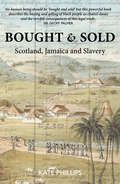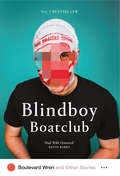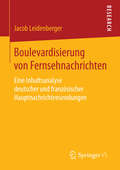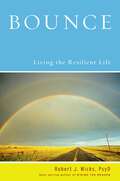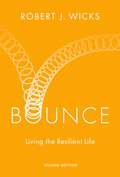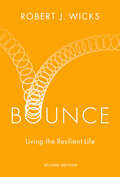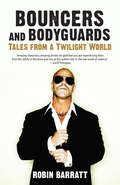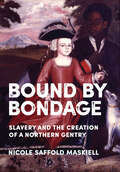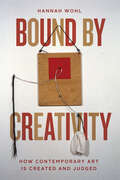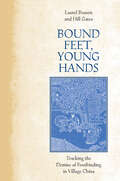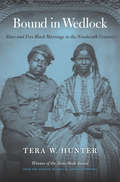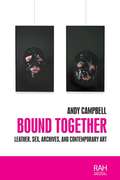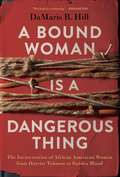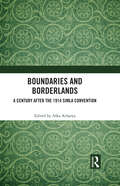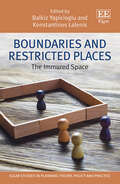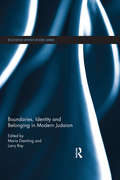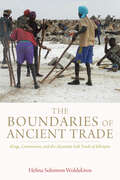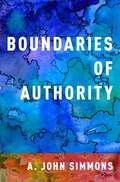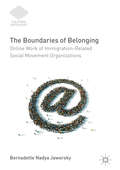- Table View
- List View
Bought & Sold: Scotland, Jamaica and Slavery
by Kate PhillipsThis book traces the story of how and why thousands of Scots made money from buying and selling humans… a story we need to own. We need to admit that many Scots were enthusiastic participants in slavery.Union with England gave Scotland access to both trade and settlement in Jamaica, Britain’s richest colony and its major slave trading hub. Tens of thousands from Scotland lived and worked there. The abolition campaign and slave revolts threatened Scottish plantation owners, merchants, traders, bankers and insurance brokers who made their fortunes from slave-farmed sugar in Jamaica and fought hard to preserve the system of slavery. Archives and parliamentary papers in both countries reveal these transatlantic Scots in their own words and allow us to access the lives of their captives. Scotland and Jamaica were closely entwined for over one hundred years. Bought & Sold traces this shared story from its early beginnings in the 1700s to the abolition of slavery in the British Empire and reflects on the meaning of those years for both nations today.
Boulevard Wren and Other Stories
by Blindboy BoatclubBoulevard Wren and Other Stories is the stunning follow-up to the bestselling Gospel According to Blindboy, and a warped mirror held up to the Irish psyche.Provocative and unsettling, the stories rove through the centuries, from the barren fields of Famine-struck Meath to the chaotic landscape of the near future, where social media has colonised the deepest recesses of the human subconscious. This is a world populated by characters lost and at odds with the demands of contemporary life, for whom the line separating redemption and madness has grown impossibly fine.Razor-sharp social satire, it is an era-defining work from one of Ireland’s most anarchic satirists and a quietly devastating portrait of a society in disarray.
Boulevardisierung von Fernsehnachrichten: Eine Inhaltsanalyse deutscher und französischer Hauptnachrichtensendungen
by Jacob LeidenbergerJacob Leidenberger setzt sich mit dem Begriff der „Boulevardisierung“ auseinander und untersucht, ob sich deutsche und französische Fernsehnachrichten zwischen 1992 und 2010 hinsichtlich der behandelten Themen, des journalistischen Stils sowie im Hinblick auf die Präsentationsformen dem Boulevardformat angenähert haben. Mittels einer quantitativen Inhaltsanalyse von 125 Nachrichtensendungen und anhand mehrerer Experteninterviews mit Nachrichtenredakteuren prüft der Autor, ob in deutschen und französischen Abendnachrichten eine Boulevardisierung stattgefunden und diese im Lauf der Zeit an Bedeutung gewonnen hat. Gerade wegen der geringen Anzahl einschlägiger Studien in beiden Ländern trägt er dazu bei, ein wenig Licht ins „Boulevardisierungs-Dunkel“ zu bringen.
Bounce: Living the Resilient Life
by Robert J. WicksStress is a fact of modern life. And as more and more people face greater financial insecurity, longer work hours, and the increasingly complex personal and social demands of our fast-paced, multi-tasking, high-tech lifestyle, finding healthy ways to handle stress is more important than ever. In Bounce: Living the Resilient Life, Robert Wicks shows you not just how to manage stress, but how to transform stressful situations into opportunities to live a more meaningful, self-aware, and compassionate life. Wicks makes available to everyone techniques he has used for over 30 years in helping physicians, nurses, psychotherapists, educators, social workers, ministers, and relief workers not only survive but flourish in highly stressful occupations. You'll learn a wide range of methods--normally reserved for those in helping and healing professions--to help you bounce back from stress and live life to the fullest. Bounce shows you how to: · Recognize the insidious nature of denial and avoidance as responses to stress · Employ psychologically powerful approaches to self-awareness · Improve self-talk through the use of cognitive behavioral principles · Apply daily-debriefing techniques · Utilize a structured reflection guide to uncover areas that require special attention · Incorporate silence, solitude, and mindfulness into daily life · Stop the drain of valuable emotional energy caused by toxic life situations and unexamined attitudes and beliefs · And much more Most important, Bounce helps you develop your own self-care protocol and personal renewal program, based on an honest assessment of your needs, life situation, and habitual ways of dealing--or failing to deal--with stress. Insightful, practical, and filled with wise guidance, Bounce shows us all how to live with greater resilience in a world that grows more stressful by the day.
Bounce: Living the Resilient Life
by Robert J. WicksEnriching the balance and meaning of life by better understanding stress and creating your own self-care protocol, Bounce shows you how to live life to the fullest. People are naturally drawn to information on how to improve self-care, create a richer circle of friends, develop and maintain a healthy perspective, and, especially now, the importance of seeing "alone-time" not simply as forced isolation but a venue for new personality development. This aids self-awareness and understanding and improves emotional intellect so we don't react but instead pause to reflect and process life as it unfolds. The original edition of Bounce addressed these areas but then came Covid-19, intense political strife, and increased divisiveness within countries, families, communities, and even faith traditions. The need to greet, successfully adjust to, and even benefit from, such unexpected and broad-reaching change, personally threatening challenges, and stress is of even greater importance now. In addition, styles of living which were taken for granted, such as adults going to work and children educated in an actual classroom, were also radically impacted. As a result, adults were also expected to quickly adapt in order to deal with the questions raised by the young about their own security and hoped-for normalcy. With updated information and a new chapter on post-traumatic growth (PTG), the second edition of Bounce is designed to enhance the search for balance and new meaning to live life to the fullest.
Bounce: Living the Resilient Life
by Robert J. WicksEnriching the balance and meaning of life by better understanding stress and creating your own self-care protocol, Bounce shows you how to live life to the fullest. People are naturally drawn to information on how to improve self-care, create a richer circle of friends, develop and maintain a healthy perspective, and, especially now, the importance of seeing "alone-time" not simply as forced isolation but a venue for new personality development. This aids self-awareness and understanding and improves emotional intellect so we don't react but instead pause to reflect and process life as it unfolds. The original edition of Bounce addressed these areas but then came Covid-19, intense political strife, and increased divisiveness within countries, families, communities, and even faith traditions. The need to greet, successfully adjust to, and even benefit from, such unexpected and broad-reaching change, personally threatening challenges, and stress is of even greater importance now. In addition, styles of living which were taken for granted, such as adults going to work and children educated in an actual classroom, were also radically impacted. As a result, adults were also expected to quickly adapt in order to deal with the questions raised by the young about their own security and hoped-for normalcy. With updated information and a new chapter on post-traumatic growth (PTG), the second edition of Bounce is designed to enhance the search for balance and new meaning to live life to the fullest.
Bounce: Living the Resilient Life
by Robert J. WicksStress is a fact of modern life. And as more and more people face greater financial insecurity, longer work hours, and the increasingly complex personal and social demands of our fast-paced, multi-tasking, high-tech lifestyle, finding healthy ways to handle stress is more important than ever. In Bounce: Living the Resilient Life, Robert Wicks shows you not just how to manage stress, but how to transform stressful situations into opportunities to live a more meaningful, self-aware, and compassionate life. Wicks makes available to everyone techniques he has used for over 30 years in helping physicians, nurses, psychotherapists, educators, social workers, ministers, and relief workers not only survive but flourish in highly stressful occupations. You'll learn a wide range of methods--normally reserved for those in helping and healing professions--to help you bounce back from stress and live life to the fullest. Bounce shows you how to: · Recognize the insidious nature of denial and avoidance as responses to stress · Employ psychologically powerful approaches to self-awareness · Improve self-talk through the use of cognitive behavioral principles · Apply daily-debriefing techniques · Utilize a structured reflection guide to uncover areas that require special attention · Incorporate silence, solitude, and mindfulness into daily life · Stop the drain of valuable emotional energy caused by toxic life situations and unexamined attitudes and beliefs · And much more Most important, Bounce helps you develop your own self-care protocol and personal renewal program, based on an honest assessment of your needs, life situation, and habitual ways of dealing--or failing to deal--with stress. Insightful, practical, and filled with wise guidance, Bounce shows us all how to live with greater resilience in a world that grows more stressful by the day.
Bouncers and Bodyguards: Tales from a Twilight World
by Robin BarrattBouncers and Bodyguards is a collection of astonishing true stories about the tough world of personal protection and nightclub doors from some of Britain's most notorious figures.Read how Charlie Bronson helped his friends out on the doors of his local in the early '70s before being banged up for well over 30 years; how Dave Courtney misses the violent world of the doors; how ex-football hooligan Mickey Francis ran most of Manchester's doors back in the '80s; and how an ex-Foreign Legion bodyguard spent over a week cooped up in a bleak warehouse guarding Iraqi votes in central Baghdad.By turns funny, sad and shocking, these candid accounts were written exclusively for this publication by individuals who have spent much of their working lives in what is a volatile, violent and frequently unpredictable industry.Compiled by former bodyguard, ex-mercenary and well-known nightclub bouncer Robin Barratt, Bouncers and Bodyguards is an exposé of an infamous twilight world about which rumours have often circulated but the truth has never really been uncovered - until now.
Bound by Bondage: Slavery and the Creation of a Northern Gentry (New Netherland Institute Studies)
by Nicole Saffold MaskiellDuring the first generations of European settlement in North America, a number of interconnected Northeastern families carved out private empires. In Bound by Bondage, Nicole Saffold Maskiell argues that slavery was a crucial component to the rise and enduring influence of this emergent aristocracy. Dynastic families built prestige based on shared notions of mastery, establishing sprawling manorial estates and securing cross-colonial landholdings and trading networks that stretched from the Northeast to the South, the Caribbean, and beyond. The members of this elite class were mayors, governors, senators, judges, and presidents, and they were also some of the largest slaveholders in the North. Aspirations to power and status, grounded in the political economy of human servitude, ameliorated ethnic and religious rivalries, and united once antagonistic Anglo and Dutch families, ensuring that Dutch networks endured throughout the English and then Revolutionary periods. Using original research drawn from archives across several continents in multiple languages, Maskiell expertly traces the origin of these private familial empires back to the founding generations of the Northeastern colonies and follows their growth to the eve of the American Revolutionary War. Maskiell reveals a multiracial Early America, where enslaved traders, woodsmen, millers, maids, bakers, and groomsmen developed expansive networks of their own that challenged the power of the elites, helping in escapes, in trade, and in simple camaraderie. In Bound by Bondage, Maskiell writes a new chapter in the history of early North America and connects developing Northern networks of merit to the invidious institution of slavery.
Bound by Creativity: How Contemporary Art Is Created and Judged
by Hannah WohlWhat is creativity? While our traditional view of creative work might lead us to think of artists as solitary visionaries, the creative process is profoundly influenced by social interactions even when artists work alone. Sociologist Hannah Wohl draws on more than one hundred interviews and two years of ethnographic research in the New York contemporary art market to develop a rich sociological perspective of creativity. From inside the studio, we see how artists experiment with new ideas and decide which works to abandon, destroy, put into storage, or exhibit. Wohl then transports readers into the art world, where we discover how artists’ understandings of their work are shaped through interactions in studio visits, galleries, international art fairs, and collectors’ homes. Bound by Creativity reveals how artists develop conceptions of their distinctive creative visions through experimentation and social interactions. Ultimately, we come to appreciate how judgment is integral to the creative process, both resulting in the creation of original works while also limiting an artist’s ability to break new ground. Exploring creativity through the lens of judgment sheds new light on the production of cultural objects, markets, and prestige.
Bound by Creativity: How Contemporary Art Is Created and Judged
by Hannah WohlWhat is creativity? While our traditional view of creative work might lead us to think of artists as solitary visionaries, the creative process is profoundly influenced by social interactions even when artists work alone. Sociologist Hannah Wohl draws on more than one hundred interviews and two years of ethnographic research in the New York contemporary art market to develop a rich sociological perspective of creativity. From inside the studio, we see how artists experiment with new ideas and decide which works to abandon, destroy, put into storage, or exhibit. Wohl then transports readers into the art world, where we discover how artists’ understandings of their work are shaped through interactions in studio visits, galleries, international art fairs, and collectors’ homes. Bound by Creativity reveals how artists develop conceptions of their distinctive creative visions through experimentation and social interactions. Ultimately, we come to appreciate how judgment is integral to the creative process, both resulting in the creation of original works while also limiting an artist’s ability to break new ground. Exploring creativity through the lens of judgment sheds new light on the production of cultural objects, markets, and prestige.
Bound Feet, Young Hands: Tracking the Demise of Footbinding in Village China
by Hill Gates Laurel BossenFootbinding was common in China until the early twentieth century, when most Chinese were family farmers. Why did these families bind young girls' feet? And why did footbinding stop? In this groundbreaking work, Laurel Bossen and Hill Gates upend the popular view of footbinding as a status, or even sexual, symbol by showing that it was an undeniably effective way to get even very young girls to sit still and work with their hands. Interviews with 1,800 elderly women, many with bound feet, reveal the reality of girls' hand labor across the North China Plain, Northwest China, and Southwest China. As binding reshaped their feet, mothers disciplined girls to spin, weave, and do other handwork because many village families depended on selling such goods. When factories eliminated the economic value of handwork, footbinding died out. As the last generation of footbound women passes away, Bound Feet, Young Hands presents a data-driven examination of the social and economic aspects of this misunderstood custom.
Bound in Wedlock: Slave and Free Black Marriage in the Nineteenth Century
by Tera W. HunterTera W. Hunter offers the first comprehensive history of African American marriage in the nineteenth century and into the Jim Crow era. She reveals the practical ways couples adopted, adapted, or rejected white Christian ideas of marriage, creatively setting their own standards for conjugal relationships under conditions of uncertainty and cruelty.
Bound together: Leather, sex, archives, and contemporary art (Rethinking Art's Histories)
by Andy CampbellWhat are the archives of gay and lesbian leather histories, and how have contemporary artists mined these archives to create a queer politics of the present? This book sheds light on an area long ignored by traditional art history and LGBTQ studies, examining the legacies of the visual and material cultures of US leather communities. It discusses the work of contemporary artists such as Patrick Staff, Dean Sameshima, Monica Majoli, AK Burns and AL Steiner, and the artist collective Die Kränken, showing how archival histories and contemporary artistic projects might be applied in a broader analysis of LGBTQ culture and norms. Hanky codes, blurry photographs of Tom of Finland drawings, a pin sash weighted down with divergent histories – these become touchstones for writing leather histories.
Bound together: Leather, sex, archives, and contemporary art (Rethinking Art's Histories)
by Andy CampbellWhat are the archives of gay and lesbian leather histories, and how have contemporary artists mined these archives to create a queer politics of the present? This book sheds light on an area long ignored by traditional art history and LGBTQ studies, examining the legacies of the visual and material cultures of US leather communities. It discusses the work of contemporary artists such as Patrick Staff, Dean Sameshima, Monica Majoli, AK Burns and AL Steiner, and the artist collective Die Kränken, showing how archival histories and contemporary artistic projects might be applied in a broader analysis of LGBTQ culture and norms. Hanky codes, blurry photographs of Tom of Finland drawings, a pin sash weighted down with divergent histories – these become touchstones for writing leather histories.
A Bound Woman Is a Dangerous Thing: The Incarceration of African American Women from Harriet Tubman to Sandra Bland
by DaMaris HillA Publishers Weekly Top 10 History Title for the seasonA revelatory work in the tradition of Claudia Rankine's Citizen, DaMaris Hill's searing and powerful narrative-in-verse bears witness to American women of color burdened by incarceration. "It is costly to stay free and appear / sane." From Harriet Tubman to Assata Shakur, Ida B. Wells to Sandra Bland and Black Lives Matter, black women freedom fighters have braved violence, scorn, despair, and isolation in order to lodge their protests. In A Bound Woman Is a Dangerous Thing, DaMaris Hill honors their experiences with at times harrowing, at times hopeful responses to her heroes, illustrated with black-and-white photographs throughout. For black American women, the experience of being bound has taken many forms: from the bondage of slavery to the Reconstruction-era criminalization of women; from the brutal constraints of Jim Crow to our own era's prison industrial complex, where between 1980 and 2014, the number of incarcerated women increased by 700%.* For those women who lived and died resisting the dehumanization of confinement--physical, social, intellectual--the threat of being bound was real, constant, and lethal. In A Bound Woman Is a Dangerous Thing, Hill presents bitter, unflinching history that artfully captures the personas of these captivating, bound yet unbridled African-American women. Hill's passionate odes to Zora Neale Hurston, Lucille Clifton, Fannie Lou Hamer, Grace Jones, Eartha Kitt, and others also celebrate the modern-day inheritors of their load and light, binding history, author, and reader in an essential legacy of struggle. *(The Sentencing Project)
Boundaries and Borderlands: A Century after the 1914 Simla Convention
by Alka AcharyaThe Simla Convention of 1914, held between Great Britain, China, and Tibet, demarcated the border between India and Tibet and gave birth to the McMahon Line. This volume critically examines the legacy of the 1914 Conference and explores its relevance in scholarly discourse about the status of Tibet and Sino-Indian relations more than a hundred years later. The book discusses the significance of the Simla Conference both in terms of the geo-politics of boundaries as well as the people and the liminal borderlands they occupy, encapsulating the culture and diversity of the trans-Himalayan regions. It explicates how colonial legacies, viz., the 1914 Simla Convention, have become virtual straitjackets, hardening the positions on the boundaries between India and China. It also looks at the debilitating consequences of the nation-state framework on more substantial investigations of the borderlands. Rich in archival material and drawing from the authors’ fieldwork in the Himalayan regions, this book analyses muted voices of the inhabitants of the region to bring into focus the larger question of the political, economic, religious, ecological and social life of the Himalayan peoples, which has enormous implications for both India and China. This volume will be of interest to students of history, international relations, sociology, strategic studies, Asian studies and anthropology.
Boundaries and Borderlands: A Century after the 1914 Simla Convention
by Alka AcharyaThe Simla Convention of 1914, held between Great Britain, China, and Tibet, demarcated the border between India and Tibet and gave birth to the McMahon Line. This volume critically examines the legacy of the 1914 Conference and explores its relevance in scholarly discourse about the status of Tibet and Sino-Indian relations more than a hundred years later. The book discusses the significance of the Simla Conference both in terms of the geo-politics of boundaries as well as the people and the liminal borderlands they occupy, encapsulating the culture and diversity of the trans-Himalayan regions. It explicates how colonial legacies, viz., the 1914 Simla Convention, have become virtual straitjackets, hardening the positions on the boundaries between India and China. It also looks at the debilitating consequences of the nation-state framework on more substantial investigations of the borderlands. Rich in archival material and drawing from the authors’ fieldwork in the Himalayan regions, this book analyses muted voices of the inhabitants of the region to bring into focus the larger question of the political, economic, religious, ecological and social life of the Himalayan peoples, which has enormous implications for both India and China. This volume will be of interest to students of history, international relations, sociology, strategic studies, Asian studies and anthropology.
Boundaries and Restricted Places: The Immured Space (Elgar Studies in Planning Theory, Policy and Practice)
This innovative book defines the concept of immured spaces across time, space and culture and investigates various categories of restricted places such as divided, segregated and protected spaces. Drawing on examples from across the world, this book analyses not only what separates and divides space, but also the wide variety of impacts that the imposition of new barriers and boundaries or the opening of existing ones has on places, people and surrounding areas. Contributors integrate case studies with theoretical analysis to draw conclusions and advance an analytical framework of immured spaces. The chapters present a point of reference to highlight areas of significance and also to encourage further detailed work in this important area.The book has a strong research dimension and will therefore be of interest to academic communities in planning, cultural heritage, psychology, architecture and urban studies. In addition, the use of case studies to develop a common framework will appeal to practitioners and policy makers.
Boundaries, Identity and belonging in Modern Judaism (Routledge Jewish Studies Series)
by Larry Ray Maria DiemlingThe drawing of boundaries has always been a key part of the Jewish tradition and has served to maintain a distinctive Jewish identity. At the same time, these boundaries have consistently been subject to negotiation, transgression and contestation. The increasing fragmentation of Judaism into competing claims to membership, from Orthodox adherence to secular identities, has brought striking new dimensions to this complex interplay of boundaries and modes of identity and belonging in contemporary Judaism. Boundaries, Identity and Belonging in Modern Judaism addresses these new dimensions, bringing together experts in the field to explore the various and fluid modes of expressing and defining Jewish identity in the modern world. Its interdisciplinary scholarship opens new perspectives on the prominent questions challenging scholars in Jewish Studies. Beyond simply being born Jewish, observance of Judaism has become a lifestyle choice and active assertion. Addressing the demographic changes brought by population mobility and ‘marrying out,’ as well as the complex relationships between Israel and the Diaspora, this book reveals how these shifting boundaries play out in a global context, where Orthodoxy meets innovative ways of defining and acquiring Jewish identity. This book is essential reading for students and scholars of Jewish Studies, as well as general Religious Studies and those interested in the sociology of belonging and identities.
Boundaries, Identity and belonging in Modern Judaism (Routledge Jewish Studies Series)
by Larry Ray Maria DiemlingThe drawing of boundaries has always been a key part of the Jewish tradition and has served to maintain a distinctive Jewish identity. At the same time, these boundaries have consistently been subject to negotiation, transgression and contestation. The increasing fragmentation of Judaism into competing claims to membership, from Orthodox adherence to secular identities, has brought striking new dimensions to this complex interplay of boundaries and modes of identity and belonging in contemporary Judaism. Boundaries, Identity and Belonging in Modern Judaism addresses these new dimensions, bringing together experts in the field to explore the various and fluid modes of expressing and defining Jewish identity in the modern world. Its interdisciplinary scholarship opens new perspectives on the prominent questions challenging scholars in Jewish Studies. Beyond simply being born Jewish, observance of Judaism has become a lifestyle choice and active assertion. Addressing the demographic changes brought by population mobility and ‘marrying out,’ as well as the complex relationships between Israel and the Diaspora, this book reveals how these shifting boundaries play out in a global context, where Orthodoxy meets innovative ways of defining and acquiring Jewish identity. This book is essential reading for students and scholars of Jewish Studies, as well as general Religious Studies and those interested in the sociology of belonging and identities.
The Boundaries of Ancient Trade: Kings, Commoners, and the Aksumite Salt Trade of Ethiopia
by Helina Solomon WoldekirosDrawing on rich ethnographic data as well as archaeological evidence, The Boundaries of Ancient Trade challenges long-standing conceptions of highly centralized sociopolitical and economic organization and trade along the Afar salt trail—one of the last economically significant caravan-based trade routes in the world. For thousands of years, farmers in the Tigray, Amhara, and Afar regions of Ethiopia and Eritrea have run caravans of nearly 250,000 people and pack animals annually along an eighty-mile route through both cold, high-altitude farmlands and some of the hottest volcanic desert terrain on earth. In her fieldwork, archaeologist Helina Solomon Woldekiros followed the route with her own donkey and camel caravan, observing and interviewing over 150 Arho (caravaners), salt miners, salt cutters, warehouse owners, brokers, shop owners, and salt village residents to model the political economy of the ancient Aksumite state. The first integrated ethnoarchaeological and archaeological research on this legendary route, this volume provides evidence that informal economies and local participation have played a critical role in regional trade and, ultimately, in maintaining the considerable power of the Aksumite state. Woldekiros also contributes new insights into the logistics of pack animal–based trade and variability in the central and regional organization of global ancient trade. Using a culturally informed framework for understanding the organization of the ancient salt route and its role in linking the Aksumite state to rural highland agricultural and lowland mobile pastoralist populations, The Boundaries of Ancient Trade makes a key contribution to theoretical discussions of hierarchy and more diffuse power structures in ancient states. This work generates new interest in the region as an area of global relevance in archaeological and anthropological debates on landscape, social interaction, and practice theories.
Boundaries of Authority
by A. John SimmonsModern states claim rights of jurisdiction and control over particular geographical areas and their associated natural resources. Boundaries of Authority explores the possible moral bases for such territorial claims by states, in the process arguing that many of these territorial claims in fact lack any moral justification. The book maintains throughout that the requirement of states' justified authority over persons has normative priority over, and as a result severely restricts, the kinds of territorial rights that states can justifiably claim, and it argues that the mere effective administration of justice within a geographical area is insufficient to ground moral authority over residents of that area. The book argues that only a theory of territorial rights that takes seriously the morality of the actual history of states' acquisitions of power over land and the land's residents can adequately explain the nature and extent of states' moral rights over particular territories. Part I of the book examines the interconnections between states' claimed rights of authority over particular sets of subject persons and states' claimed authority to control particular territories. It contains an extended critique of the dominant "Kantian functionalist" approach to such issues. Part II organizes, explains, and criticizes the full range of extant theories of states' territorial rights, arguing that a little-appreciated Lockean approach to territorial rights is in fact far better able to meet the principal desiderata for such theories. Where the first two parts of the book concern primarily states' claims to jurisdiction over territories, Part III of the book looks closely at the more property-like territorial rights that states claim - in particular, their claimed rights to control over the natural resources on and beneath their territories and their claimed rights to control and restrict movement across (including immigration over) their territorial borders.
BOUNDARIES OF AUTHORITY C
by A. John SimmonsModern states claim rights of jurisdiction and control over particular geographical areas and their associated natural resources. Boundaries of Authority explores the possible moral bases for such territorial claims by states, in the process arguing that many of these territorial claims in fact lack any moral justification. The book maintains throughout that the requirement of states' justified authority over persons has normative priority over, and as a result severely restricts, the kinds of territorial rights that states can justifiably claim, and it argues that the mere effective administration of justice within a geographical area is insufficient to ground moral authority over residents of that area. The book argues that only a theory of territorial rights that takes seriously the morality of the actual history of states' acquisitions of power over land and the land's residents can adequately explain the nature and extent of states' moral rights over particular territories. Part I of the book examines the interconnections between states' claimed rights of authority over particular sets of subject persons and states' claimed authority to control particular territories. It contains an extended critique of the dominant "Kantian functionalist" approach to such issues. Part II organizes, explains, and criticizes the full range of extant theories of states' territorial rights, arguing that a little-appreciated Lockean approach to territorial rights is in fact far better able to meet the principal desiderata for such theories. Where the first two parts of the book concern primarily states' claims to jurisdiction over territories, Part III of the book looks closely at the more property-like territorial rights that states claim - in particular, their claimed rights to control over the natural resources on and beneath their territories and their claimed rights to control and restrict movement across (including immigration over) their territorial borders.
The Boundaries of Belonging: Online Work of Immigration-Related Social Movement Organizations (Cultural Sociology)
by Bernadette Nadya JaworskyThis book addresses an issue currently making political headlines in the United States—immigration. Immigrants have long engendered debates about the boundaries of belonging, with some singing their praises and others warning of their dangers. In particular, the 11 million unauthorized immigrants in the country provoke heated disagreements with issues of legality and morality at the forefront. Increasingly, such debates take place online, by organizations in the immigrant rights and the immigration control movements, who engage in symbolic work that includes blurring, crossing, maintaining, solidifying, and shifting the boundaries of belonging. Based on data collected from 29 national-level groups, this book features a cultural sociological analysis of the online materials deployed by social movement organizations debating immigration in the United States.
